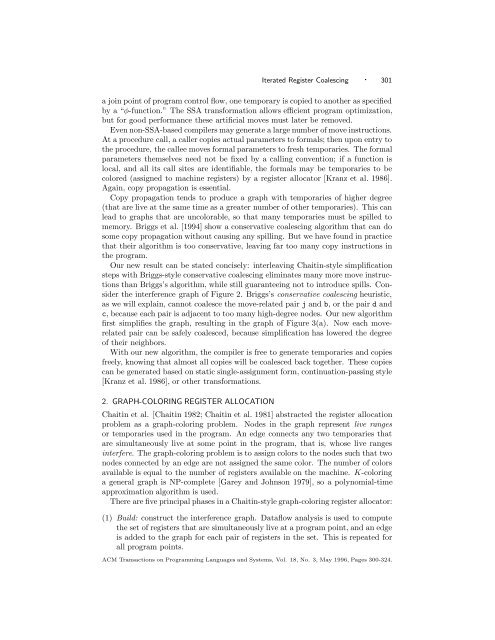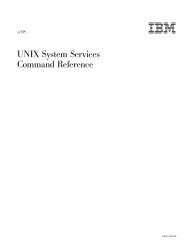Iterated Register Coalescing - School of Computer Science
Iterated Register Coalescing - School of Computer Science
Iterated Register Coalescing - School of Computer Science
Create successful ePaper yourself
Turn your PDF publications into a flip-book with our unique Google optimized e-Paper software.
<strong>Iterated</strong> <strong>Register</strong> <strong>Coalescing</strong> · 301a join point <strong>of</strong> program control flow, one temporary is copied to another as specifiedby a “φ-function.” The SSA transformation allows efficient program optimization,but for good performance these artificial moves must later be removed.Even non-SSA-based compilers may generate a large number <strong>of</strong> move instructions.At a procedure call, a caller copies actual parameters to formals; then upon entry tothe procedure, the callee moves formal parameters to fresh temporaries. The formalparameters themselves need not be fixed by a calling convention; if a function islocal, and all its call sites are identifiable, the formals may be temporaries to becolored (assigned to machine registers) by a register allocator [Kranz et al. 1986].Again, copy propagation is essential.Copy propagation tends to produce a graph with temporaries <strong>of</strong> higher degree(that are live at the same time as a greater number <strong>of</strong> other temporaries). This canlead to graphs that are uncolorable, so that many temporaries must be spilled tomemory. Briggs et al. [1994] show a conservative coalescing algorithm that can dosome copy propagation without causing any spilling. But we have found in practicethat their algorithm is too conservative, leaving far too many copy instructions inthe program.Our new result can be stated concisely: interleaving Chaitin-style simplificationsteps with Briggs-style conservative coalescing eliminates many more move instructionsthan Briggs’s algorithm, while still guaranteeing not to introduce spills. Considerthe interference graph <strong>of</strong> Figure 2. Briggs’s conservative coalescing heuristic,as we will explain, cannot coalesce the move-related pair j and b, or the pair d andc, because each pair is adjacent to too many high-degree nodes. Our new algorithmfirst simplifies the graph, resulting in the graph <strong>of</strong> Figure 3(a). Now each moverelatedpair can be safely coalesced, because simplification has lowered the degree<strong>of</strong> their neighbors.With our new algorithm, the compiler is free to generate temporaries and copiesfreely, knowing that almost all copies will be coalesced back together. These copiescan be generated based on static single-assignment form, continuation-passing style[Kranz et al. 1986], or other transformations.2. GRAPH-COLORING REGISTER ALLOCATIONChaitin et al. [Chaitin 1982; Chaitin et al. 1981] abstracted the register allocationproblem as a graph-coloring problem. Nodes in the graph represent live rangesor temporaries used in the program. An edge connects any two temporaries thatare simultaneously live at some point in the program, that is, whose live rangesinterfere. The graph-coloring problem is to assign colors to the nodes such that twonodes connected by an edge are not assigned the same color. The number <strong>of</strong> colorsavailable is equal to the number <strong>of</strong> registers available on the machine. K-coloringa general graph is NP-complete [Garey and Johnson 1979], so a polynomial-timeapproximation algorithm is used.There are five principal phases in a Chaitin-style graph-coloring register allocator:(1) Build: construct the interference graph. Dataflow analysis is used to computethe set <strong>of</strong> registers that are simultaneously live at a program point, and an edgeis added to the graph for each pair <strong>of</strong> registers in the set. This is repeated forall program points.ACM Transactions on Programming Languages and Systems, Vol. 18, No. 3, May 1996, Pages 300-324.









